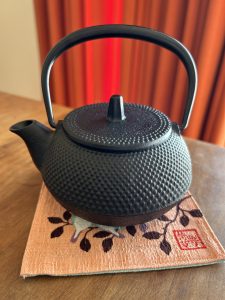鉄瓶の表と裏(愛知県名古屋市千種区 骨董買取 古美術風光舎)
2023.06.18
皆さまこんにちは。スタッフHでございます。
また愛用品の話で申し訳ないのですが、ここ数年使用している南部鉄器の鉄瓶です。
皆さま鉄瓶に表と裏があることをご存じでしたか?私は初耳でした。


注ぎ口が右を向いているものと左を向いているもの、どちらが表を向いていると思いますか?
お客様の前で振る舞う時に、お客様側から見える面が鉄瓶の表となるそうです。写真だと注ぎ口が右側にある方の置き方が正しいそうです。
南部鉄器のお店ではこの向きで陳列されていることが多いとのこと。
鉄瓶に表と裏があるのは、客を大切にする「茶の湯」をきっかけに生まれたものだからかもしれません。
今使用しているものはかなり小ぶりで容量は300mlほどです。一番小さなガスコンロの火にピッタリのサイズです。
こんな小さな鉄瓶に意味があるのかと思われる方もいるかもしれませんね。
しかし私には最適なサイズでした。
以前貧血気味だった頃に友人に南部鉄瓶を勧められました。
溶出する鉄のほとんどが体に吸収されやすい二価鉄です。沸かしたお湯を飲むだけで鉄不足が改善されるなら手軽でいいなと感じました。
ただ南部鉄瓶はかなりの重量があり、お手入れも大変そう…と購入を躊躇していましたが、
こんなに小さなサイズがあるのならと購入しました。
軽くてすぐに乾くし、出しっぱなしにしていてもデザイン性があるので楽しめます。
よく使うもので、出しっぱなしにしても可愛いものは、なんだかお得な感じがします。
「南部鉄器」と聞いて最初に思い浮かぶプツプツとした「あられ模様」。
諸説ありますが、あられ模様は「霰(あられ)」が降る景色を表現したものとも言われています。
雨より小粒な霧雨が降っているような霞のかかった景色。それを細かな“てん”で表現しています。
“てん”は鋳型に一つ一つ手作業でつけていきます。まさに職人技ですね。
またあられ模様をつけることで鉄瓶の表面積が増し、保温効果が増すそうです。
先人の知恵と緻密なデザインは今も受け継がれ、国内だけにとどまらず、海外でも人気を集めています。手作業のため、一つ一つちがっているのもまた魅力の一つです。
鉄瓶で沸かしたお湯は、まろやかで美味しいとよく言われます。それは鉄分が溶け出すことで水の味が柔らかくなり、カルキが鉄瓶の内側に吸着するからだそうです。
鉄瓶はお茶だけでなく、コーヒーや紅茶も美味しくしてくれます。
しっかりした作りの鉄瓶には釜師と呼ばれる職人の手で「金気止め(釜焼き)という内側処理がされ、仕上げに1000度以上の高温で炭焼きすることで、内面に酸化被膜を形成しサビ止めの役割を果たします。
丁寧に使えば何代にもわたって使い続けることができます。
私もこの小さな鉄瓶を大切に使い続けたいと思います。
それでは、またお会いしましょう。
Hello everyone. This is Staff H.
I am sorry to talk about my favorite product again, but I have been using a Nambu tetsubin (iron kettle) for the past several years.
Did you all know that tetsubin tetsubin have a front and back? I had never heard of it before.
Which do you think faces the front, the one with the spout facing right or the one with the spout facing left?
When serving in front of customers, the side that can be seen from the customer’s side is said to be the front side of the tetsubin. In the photo, the one with the spout on the right is the correct one.
In many stores selling Nambu tetsubin, the tetsubin is displayed in this orientation.
The reason why tetsubin have a front and back side may be because they were born out of the “chanoyu,” a Japanese tea ceremony in which guests are cherished.
The one used now is quite small and has a capacity of about 300 ml. It is the perfect size for the smallest gas stove flame.
Some may wonder what the significance of such a small tetsubin is.
When I used to be anemic, a friend recommended a Nanbu Tetsubin to me.
Most of the iron that leaches out is divalent iron, which is easily absorbed by the body. I thought it would be nice and easy if I could improve my iron deficiency just by drinking boiled water.
However, I was hesitant to purchase a Nanbu Tetsubin because it is quite heavy and I thought it would be difficult to care for.
However, I purchased this kettle because of its small size.
It is lightweight, dries quickly, and even if I leave it out, I can enjoy it because of its design.
I feel like I am getting a good deal on something that I use often and that is pretty even if I leave it out.
The first thing that comes to mind when one hears the name “Nanbu Tekki” is the “hail pattern.
There are various theories, but it is said that the hail pattern expresses the scenery of falling “hail.
The haze pattern is said to represent a hazy landscape with a drizzle that is smaller than rain. This is expressed by the fine “ten” (ten).
Each “ten” is placed one by one on the mold by hand. This is truly craftsmanship.
The hail pattern also increases the surface area of the tetsubin, which in turn increases the heat-retaining effect.
The wisdom and intricate designs of our ancestors have been handed down to the present day and are popular not only in Japan but also overseas.
The fact that each tetsubin is made by hand makes it unique, which is one of the charms of tetsubin.
It is often said that water boiled in an iron kettle tastes mild and delicious. This is because the taste of the water is softened by the dissolved iron, and the chalky water is absorbed by the inside of the tetsubin.
Tetsubin tetsubin not only make tea, but also coffee and tea.
The inside of a solidly made tetsubin is treated by a craftsman called a kamashi (potter) in a process called kamayaki, and then finished by charcoal baking at a high temperature of 1,000°C or more, which forms an oxide film on the inside surface and prevents rust.
If used carefully, the tetsubin can be used for generations to come.
I would like to continue to use this small tetsubin with great care.
I hope to see you again soon.
*******************
ご実家の整理やお片付けなどをされている方のご相談などが多くございます。
お片付けなどくれぐれもご無理のないようになさってくださいませ。
風光舎では古美術品や骨董品の他にも絵画や宝石、趣味のお品など様々なジャンルのものを買受しております。
お片付けをされていて、こういうものでもいいのかしらと迷われているものでも、どうぞお気軽にご相談下さいませ。
また風光舎は、出張買取も強化しております。ご近所はもちろん、愛知県内、岐阜県、三重県その他の県へも出張いたします。
まずは、お電話お待ちしております。
愛知県名古屋市千種区姫池通
骨董 買取【古美術 風光舎 名古屋店】
TEL052(734)8444
10:00-17:00 OPEN
#出張買取#骨董#古美術#骨董品#絵画#版画#茶道具#刀剣#彫刻

